
The Scorpaeniformes are a diverse order of ray-finned fish, including the lionfishes and sculpins, but have also been called the Scleroparei. It is one of the five largest orders of bony fishes by number of species, with over 1,320.

Gasterosteoidei is a suborder of ray-finned fishes that includes the sticklebacks and relatives, the 5th edition of Fishes of the World classifies this suborder within the order Scorpaeniformes.

The sticklebacks are a family of ray-finned fishes, the Gasterosteidae which have a Holarctic distribution in fresh, brackish and marine waters. They were thought to be related to the pipefish and seahorses but are now thought to be more closely related to the eelpouts and sculpins.
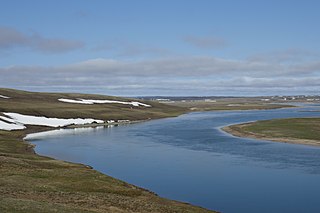
The Thomsen River, located in the Northwest Territories of Canada, is the northernmost usable river of the country. It is famous for canoeing.

The ninespine stickleback, also called the ten-spined stickleback, is a freshwater species of fish in the family Gasterosteidae that inhabits temperate waters. It is widely but locally distributed throughout Eurasia and North America. Despite its name, the number of spines can vary from 8 to 12.

The brook stickleback is a small freshwater fish that is distributed across the US and Canada. It grows to a length of about 2 inches. It occupies the northern part of the eastern United States, as well as the southern half of Canada. Small populations are scattered throughout the Mississippi-Great Lakes basin extending to Colorado, New Mexico, Kentucky, Tennessee, etc., though some of these areas are not native to the species. This small fish inhabits clear, cool streams and lakes. They eat small invertebrates, algae, insect larvae, and occasionally their own eggs. They are also preyed upon by smallmouth bass and northern pike. Feedin time is usually dawn and sunset. The brook stickleback does have active competition mostly from minnows, but feeding times are different, along with diet. Spawning occurs in midsummer. Males secure a territory, build a nest, and mate with females. Males provide protection for the eggs, ward off predators, and usually die later in the season. This is considered an annual species. The nests are built out of aquatic grasses. Though the brook stickleback is not considered a threatened species, deforesting and changing waters are altering ecosystems of the species. Harvesting of trees around riparian environments is having a large effect of the stream ecosystem where the brook stickleback resides.
Pungitius hellenicus, the Greek ninespine stickleback or ellinopygósteos, is a species of fish in the family Gasterosteidae. It is endemic to Greece. Its natural habitats are rivers and freshwater spring. It is threatened by habitat loss and considered critically endangered in the International Red List of IUCN, Bern Convention.

The Ukrainian stickleback also known as the Caspian ninespine stickleback, southern ninespine stickleback, and Aral ninespine stickleback, is a species of fish in the family Gasterosteidae. It is found in Afghanistan, Bulgaria, Iran, Kazakhstan, Moldova, Romania, Russia, Serbia, Montenegro, and Ukraine.
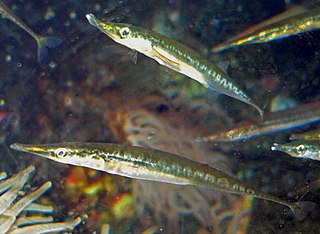
Aulorhynchus is a monospecific genus of marine ray-finned fish belonging to the family Aulorhynchidae. Its only species is the tube-snout which is found off the western coast of North America.

Aulorhynchidae, the tube-snouts, is a small family of marine ray-finned fishes belonging to the suborder Gasterosteoidei in the order Scorpaeniformes. These fishes are found in the northern Pacific Ocean.
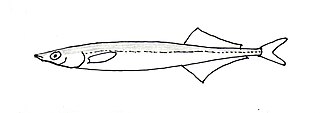
The Korean sandlance is a species of marine ray-finned fish belonging to the family Hypoptychidae. The Korean sandlance is the only species in this monotypic family and genus and is found in the northwestern Pacific Ocean.
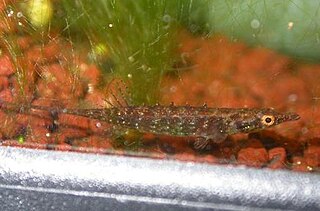
Indostomus is a genus of small fishes native to slow moving or stagnant freshwater habitats in Indochina. It is the sole genus of the monogeneric family Indostomidae, Long considered to be sticklebacks, within the order Gasterosteiformes, modern analyses place the Indostomids within the order Synbranchiformes, related to the spiny eels and swamp eels.

Gasterosteus is a genus of ray-finned fishes belonging to the family Gasterosteidae, the sticklebacks. These fishes are found in freshwater, brackish water and marine habitats in the Holarctic region.
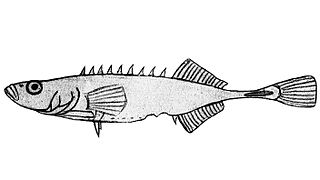
The Amur stickleback is a species of fish in the family Gasterosteidae. This freshwater, brackish water, or marine benthopelagic fish is usually 6.5 cm in length. It is widespread in East Asia: off the Korean peninsula, northeast and north China, Japan, the Kuril Islands, the Kamchatka peninsula, and the basin of the Amur River.

The Sakhalin stickleback is a fish of the family Gasterosteidae. It is a freshwater benthopelagic fish, that grows up to 7.0 cm in length. It is endemic to the islands of Hokkaido and Sakhalin.
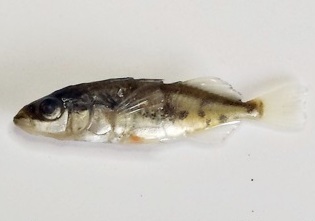
The blackspotted stickleback is species of ray-finned fish belonging to the family Gasterosteidae, the sticklebacks. This fish is found in the western Atlantic from the coasts of Newfoundland (Canada) to Massachusetts. This is a benthopelagic species of marine and brackish waters, rarely entering freshwater, which remains near the shore. It is frequently associated with floating vegetation. The male builds a nest, in which the females deposit eggs and the male guards and aerates them. It is a small fish which reaches a maximum published total length of 7.6 cm (3.0 in), although 3.5 cm (1.4 in) is more typical. The specific name honors Richard H. Wheatland who was the Cabinet Keeper, for the Essex County Natural History Society of Salem, Massachusetts and who collected type of this species in 1859.
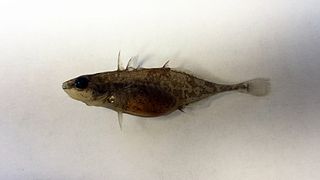
Apeltes is a monospecific genus old ray-finned fish belonging to the family Gasterosteidae, the sticklebacks. The only species in the genus is Apeltes quadracus, the fourspine stickleback or bloody stickleback, which lives in freshwater, brackish and benthopelagic environments of the northwestern Atlantic Ocean between Newfoundland and South Carolina.
Acanthocephalus dirus is a species of parasitic worm in the Echinorhynchidae family. Instead of having its eggs expelled from the host in feces, the gravid female detaches itself from the host's digestive tract and sinks to the bottom, where her body is consumed by the species' intermediate host, Caecidotea intermedius, a species of isopod. Upon hatching, the larvae begin to alter their host's behavior. This will manifest in lighter pigmentation and an increased attraction to predators, such as A. dirus' primary hosts.

The Musashi ninespine stickleback is an undescribed species of fish in the stickleback genus Pungitius. Endemic to Japan, it occurs only in the Motoara River in Kumagaya, Saitama Prefecture. It is the prefectural fish, its habitat has been designated a prefectural natural monument, and a main belt asteroid, the minor planet 10776 Musashitomiyo, has been named in its honour. It is assessed as Critically Endangered on the 2020 Ministry of the Environment Red List.

Pungitius laevis, commonly known as smoothtail ninespine stickleback, is a species of freshwater fish of the family Gasterosteidae. It is distributed in temperate brackish benthopelagic waters of coastal western Europe.

















